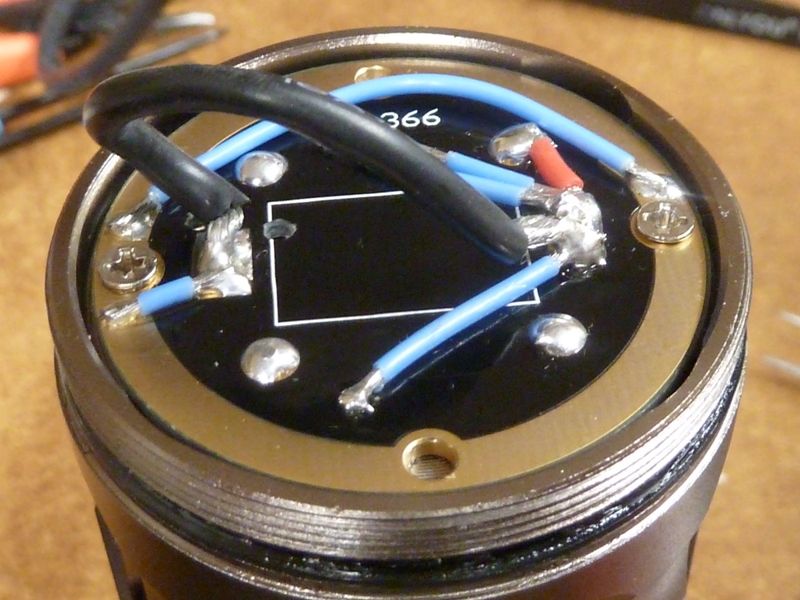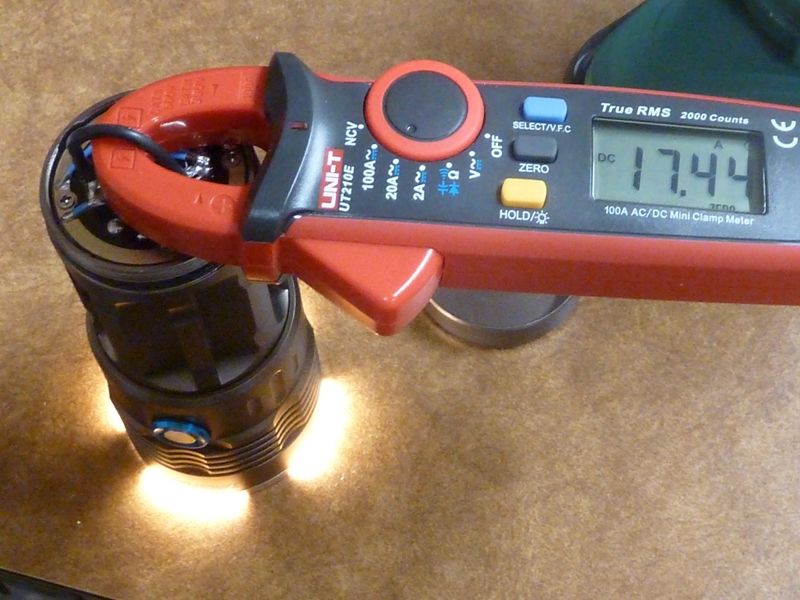More modding, of course! Just not happy bout not getting the max amps out of all those purty stacked 7135's (thanx btw for the complements!!). So, I upgraded the 20 AWG driver LED wires to 18 AWG, 18 AWG shown here:



Results? Somewhat disappointing, raising tail amps from 14.78A to 15.0A. This justifies what Richard says about the impact of heavier gauge wires - relatively low.
So what next? I am getting 15.0A measured, but theoretically the 7135's should get 18.08A. Well again I refer to Richard's comments. He said the traces on the SRK driver probably can't handle this amount of high amps, and I believe him from looking at it. Well, that's fixable easy enough. Just add some decent jumper wires to supplement the traces. I'm thinking the bottleneck is for the traces of the 7135 outputs to the pad where that big black 18 AWG wire is soldered. So, create a pad right next to it:

And run 26 AWG teflon coated wire jumpers from the outer most 7135's to that pad. Sorry, don't have a pic, but it's 3 wires connected to 3 different stacked 7135 output pins, about evenly spaced to the outer banks. Results?
Ok - recovered almost all those missing amps. New reading (again at full charge SAM 30Q BT's) is 17.6A at start. Here's my tailcap with the built-in 16 AWG loop:

Here's a live reading after the measurements, so it's dropped a little:

New Measurements:
tail: 17.6A (clamp meter), lumens: 6,222 @start, 5,953 @30 secs, 52 kcd taken at 5 meters (456 meters)
Again, in a pretty nice neutral tint (4 U3 3D's, 1 U4 1C)
I do love this UT210E meter btw... Ohh, and Thanks Again Richard for this No Drama Group Buy!!
![]() Lead pads are also usually in a better configuration. Still, looks like you’re getting really close to the desired result, sucks that the 22ga leads had to be used up top, 20’s would be nice, perhaps a 20ga Teflon lead coming off the emitters? The 20ga Teflon is usually even slimmer than 22ga Silicone. Then you could use 20 or 18ga inside the pill to deliver to the short through-shelf of the Teflons.
Lead pads are also usually in a better configuration. Still, looks like you’re getting really close to the desired result, sucks that the 22ga leads had to be used up top, 20’s would be nice, perhaps a 20ga Teflon lead coming off the emitters? The 20ga Teflon is usually even slimmer than 22ga Silicone. Then you could use 20 or 18ga inside the pill to deliver to the short through-shelf of the Teflons. First read off the UT…
First read off the UT… Second read off the UT…
Second read off the UT… And it repeated several time after this, the same way too high? Any ideas? When I first got it a couple months ago, it was spot on to my Fluke36 now it’s all over the place?/ Any one seen this before I really like this meter too, nice and compact and easier to handle then the Fluke.
And it repeated several time after this, the same way too high? Any ideas? When I first got it a couple months ago, it was spot on to my Fluke36 now it’s all over the place?/ Any one seen this before I really like this meter too, nice and compact and easier to handle then the Fluke.




